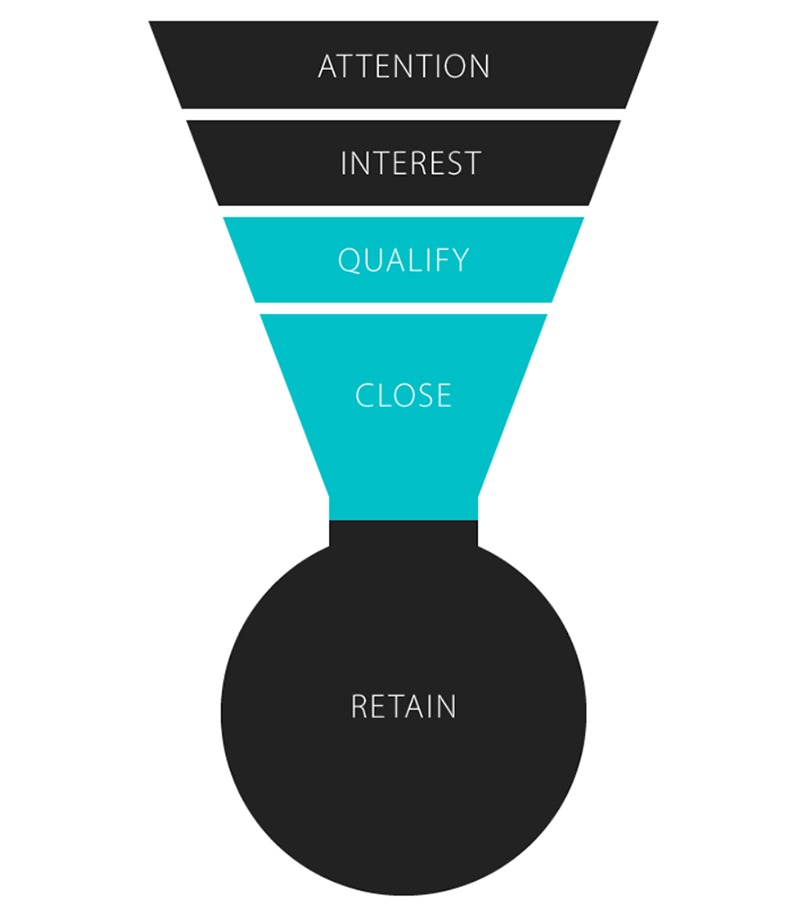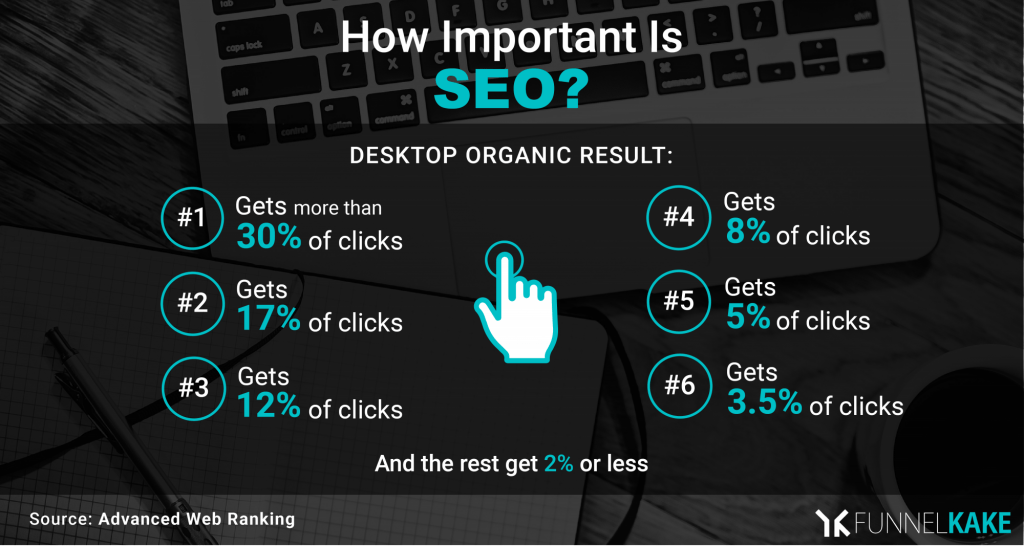While it sounds like an app for your online shop, the e-commerce sales funnel is anything but. It’s a method by which you make customers aware of your brand and products and nurture them through to purchase.
E-commerce sales are growing at a furious pace. According to census.gov, in 2009, e-commerce sales accounted for roughly 4% of all retail sales. In Q2 of 2018, they accounted for 9.6% of total sales, or $127.3 Billion. This growth is projected to continue through at least 2022 and has created massive competition among retailers, with some losers along the way.
A significant portion of that growth is swallowed up by the big e-commerce players – Amazon, Apple, and Wal-Mart to name a few. But that’s not to say there’s no room for small and medium-sized businesses to do very well if they understand how to optimize their e-commerce sales funnel.
Unfortunately, the buyer journey is rarely a linear one. It may take 3 visits to the website to capture their purchase. But once you do that, and capture their contact information, selling to them again is the key to growing revenue.
Why optimizing the e-commerce sales funnel is so important.
A frustrating reality of e-commerce is that few people buy from your online shop the first time they visit. According to Think With Google, shoppers often begin their journey undecided on what brand and product they wish to purchase… And 60% of smartphone users say they’ve discovered a new company or product when conducting a search on their smartphones.
And that’s why the sales funnel (aka digital marketing funnel) is so imperative. As users discover your brand, self-select, and leave or move down the funnel, they become more qualified and move closer to purchase. Depending on your industry, the average e-commerce sales funnel conversion rate is around 3%. That means you need to push a ton of qualified traffic through your site to deliver significant sales.

FunnelKake’s 5-step sales funnel.
Steps in the e-commerce sales funnel.
The 4 steps in a typical e-commerce sales funnel are Awareness (top of the funnel), Interest, Decision, and Action (bottom of the funnel). At FunnelKake, we’ve developed a 5-step funnel: Attention, Interest, Qualify, Close, Retain.
At the top of the funnel, not all traffic to your site is created equally. We not only want to make users aware of your brand and products but actually get their attention and pique their interest to learn more. This movement into the funnel qualifies them, and qualified traffic delivers a much higher conversion rate. After the sale (or close), retention is key, as these customers have already bought from you and are primed to buy again. And again. And again.
How to get the Attention and Interest of your target customer.
Getting a user’s attention and interest is a 2-part process: 1) the ad or organic search result builds awareness and 2) the destination page builds their interest.
Think of a brand you’re aware of but haven’t bought from yet. In the e-commerce sales funnel steps, they’ve captured your awareness, but not your attention. If you decide to visit the website again, your awareness has moved to interest, and you’ve entered the sales funnel.
At the start, a customer may not know you exist and may not know how your product can solve their problem. Here, at the top of the funnel, we’re looking for as many potential qualified customers as possible. This is where digital advertising, organic search, and social media marketing are utilized to drive users to your product pages.
It’s all about the click.
Every e-commerce search query is an effort to solve a need or a want: I want to buy a book, I need a new tool for my job, how much are flights to Tahiti, what is the best skin moisturizer, what is the warmest down jacket, I need a suit for work. Effective digital ads anticipate these queries based on keyword research (humans are so alike that we all search for the same stuff in nearly the same way).
Social media ads are a little different – they aren’t served in response to a request (mostly), but are interruptive ads, in the model of radio and TV. Just as the ads on those old school media interrupt programming, ads on social media interrupt your feed. Using audience targeting information provided by the social media platform, ads are shown to you based on what the platform predicts you might be interested in.
SEO is essential to your strategy.
But the big kahuna for almost every e-commerce business is organic search. This is why Search Engine Optimization (SEO) must be key to your marketing strategy. First, if your page, product or post doesn’t rank highly on a search engine results page (SERP), it will never – or rarely – be seen, much less clicked on. Secondly, the text in the search result should assure the user that your product is the one that’s going to solve his/her problem or want. Which gets you the click.
Once the user is on your site, it’s all about first impressions. Get them interested and excited, and there’s an excellent chance they’ll make the decision to buy. But this will only happen if your website delivers a great user experience (UX) and your product page gives the visitor confidence that your product is the best choice. Many factors play into effective on page content and user experience, which we’ll cover in a later blog post.

How to qualify e-commerce website visitors.
The trickiest part of the e-commerce sales funnel is qualifying traffic. Any and all visitors to a website are appreciated, but we’re really only interested in those who will go to the next step of the funnel.
Content is how we qualify the user, and it’s the point at which you lose the new customer or move them through the funnel towards a purchase.
Great content on a landing page, home page, blog post, white paper, etc., makes the case for your product and brand clearly, has great visuals, a logical flow, and demonstrates why a user needs it and what problem it’s going to solve. Clear, compelling product descriptions are absolutely essential.
It’s with content that we also prove value – customer reviews being the most powerful. User-generated content can also be valuable, such as an unboxing video or a video showing the product in use.
How to close customers and get the sale.
If the user has decided to stick around after reading your incredibly interesting content which perfectly solves their problem, it’s now time to close them.
If they have confidence in your brand, they may be ready. But they’ll always have that nagging question in the back of their minds, Is this the best price?
Pricing is a tricky matter. If your product is one of a kind, you can charge the perceived value of the product. Perceived value is determined by how efficiently your product solves the buyer’s problem. If you’re a reseller, you have to compete on price or incentivize first time buyers to purchase from your site vs your competitors.
How to get the purchase:
- Experiment with pricing – discounts for quantity buys, first-time buyers, certain groups of people (like veterans or educators), limited sales, etc.
- Free shipping is the most magical phrase in e-commerce. If you can adjust your price to cover the average shipping costs, you’ll win.
- Think about bundling products, offering free samples, or an introductory BOGO.
- Speed checkout by auto-populating fields. This removes friction in the buying path and moves the customer to the “buy now” button faster.
- Accept as many forms of payment as possible.
How to Retain customers
You’ve noticed by now that almost every e-commerce site in the world serves a popup asking for your email address in return for an incentive to buy. While users may find this slightly annoying, it’s very effective. If you don’t capture a user’s email address at the beginning of the e-commerce sales funnel, once they leave the site, you have no way to get them back.
Now that you’ve spent money to get that new customer (because ads cost money), an email marketing strategy can be used to retain them. Not selling to them again is unthinkable, and with the power of your email list, it’s free.
With well-planned email marketing, you can do anything from blasting the entire list periodically with sales announcements, notifying them of new blog posts, or segmenting the list to suggest X, Y and Z product to customers who bought W product, and many other possibilities.
Want to learn more about how to optimize your e-commerce sales funnel?

